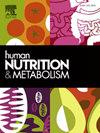维持性血液透析患者肌肉减少症和肠道菌群改变的患病率和危险因素:一项多中心研究
IF 1.8
Q3 ENDOCRINOLOGY & METABOLISM
引用次数: 0
摘要
目的调查维持性血液透析(MHD)患者营养不良和肌肉减少症的患病率,并确定与肌肉减少症和肠道微生物群多样性改变相关的潜在危险因素。方法从4家医院血液透析中心招募定期血液透析3个月以上的高血压患者。评估饮食摄入量、人体测量、身体成分和生化参数。分别使用GLIM标准和2019 AWGS标准诊断营养状况和肌肉减少症。通过16S rRNA测序分析肠道菌群组成。使用多元逻辑回归分析肌肉减少症和肠道微生物群多样性改变的潜在危险因素。结果总体营养不良患病率为50.2%(轻度37%,重度13.2%),肌肉减少症患病率为20.6%。抑郁症状与肌肉减少症风险增加显著相关(校正OR = 5.04, p = 0.004)。相比之下,高尿酸血症和高BMI均显示出对肌肉减少症的保护性关联(p <; 0.001和p = 0.004)。较高的SGA评分(aOR = 2.59, 95% CI: 1.66-4.05, p < 0.001)和较高的BMI (aOR = 1.12, 95% CI: 1.00-1.25, p = 0.038)与肠道微生物多样性呈正相关,而升高的甘油三酯水平呈负相关(aOR = 0.61, 95% CI: 0.43-0.87, p = 0.006)。结论抑郁状态可增加骨骼肌减少症的发生风险,而适度升高的尿酸水平可能是预防骨骼肌减少症的保护因素。良好的营养状况和健康的BMI有利于MHD患者维持肠道微生物多样性。本文章由计算机程序翻译,如有差异,请以英文原文为准。
Prevalence and risk factors of sarcopenia and altered gut microbiota in maintenance hemodialysis patients: A multi-center study
Objective
To investigate the prevalence of malnutrition and sarcopenia and to identify potential risk factors associated with sarcopenia and with alterations in gut microbiota diversity among maintenance hemodialysis (MHD) patients.
Methods
MHD patients undergoing regular hemodialysis for more than 3 months were recruited from four hospital hemodialysis centers. Dietary intake, anthropometric measures, body composition, and biochemical parameters were assessed. Nutritional status and sarcopenia were diagnosed using the GLIM criteria and the 2019 AWGS criteria, respectively. Gut microbiota composition was analyzed via 16S rRNA sequencing. Potential risk factors for both sarcopenia and altered gut microbiota diversity were analyzed using multivariate logistic regression.
Results
The overall prevalence of malnutrition was 50.2 % (37 % mild, 13.2 % severe), and sarcopenia was 20.6 %. Depression symptom was significantly associated with an increased risk of sarcopenia (adjusted OR = 5.04, p = 0.004). In contrast, both hyperuricemia and higher BMI showed a protective association against sarcopenia (p < 0.001 and p = 0.004, respectively). Higher SGA score (aOR = 2.59, 95 % CI: 1.66–4.05, p < 0.001) and elevated BMI (aOR = 1.12, 95 % CI: 1.00–1.25, p = 0.038) were positively associated with gut microbial diversity, whereas increased triglyceride levels were negatively associated (aOR = 0.61, 95 % CI: 0.43–0.87, p = 0.006).
Conclusion
Depressive status was an increased risk of sarcopenia, while moderately elevated uric acid levels may deem as a protective factor against sarcopenia. Better nutritional status and healthy BMI were beneficial for maintaining gut microbial diversity in MHD patients.
求助全文
通过发布文献求助,成功后即可免费获取论文全文。
去求助
来源期刊

Human Nutrition and Metabolism
Agricultural and Biological Sciences-Food Science
CiteScore
1.50
自引率
0.00%
发文量
30
审稿时长
188 days
 求助内容:
求助内容: 应助结果提醒方式:
应助结果提醒方式:


